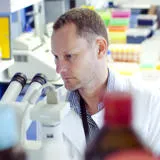We study neurodevelopmental conditions and try to uncover the mechanisms underlying congenital disease. Our work looks at the function of signalling regulators and chromatin remodelling factors in development.
We’re looking at the epigenetic mechanisms that cause ataxia, developmental delay, autism, intellectual disability and executive dysfunction. Using mouse models, we identify the functions of chromatin remodelling factors during brain development and tumourigenesis.

